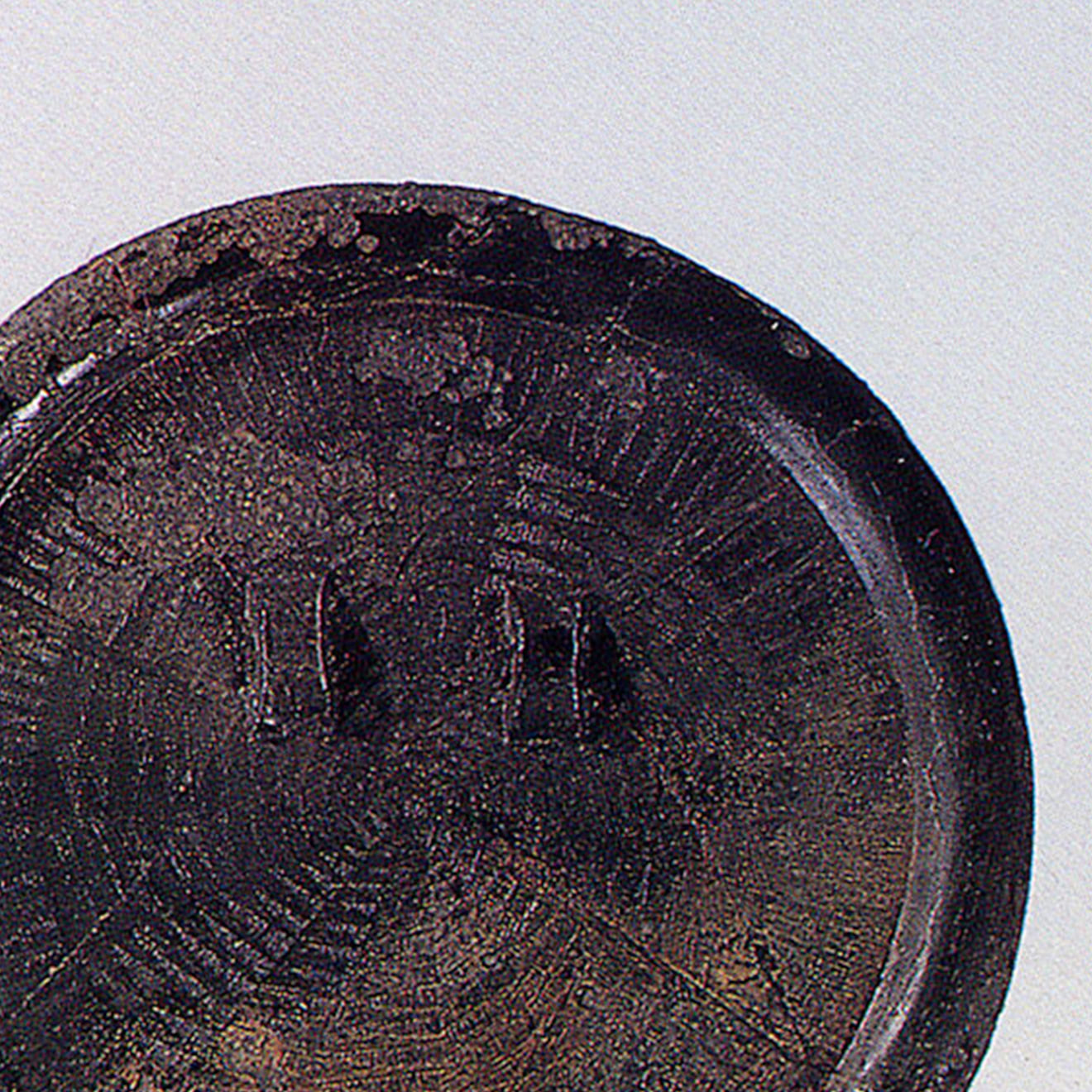
-
Bronze Mirror with Fine Linear Design
Early Iron Age (2nd century BCE)
Diameter 15.6cm
The Bronze Mirror with Fine Linear Design was excavated in Chopo-ri, Hampyeong, Jeolloanam-do Province. The Chopo-ri site is comprised of stone mound tombs that are considered to be created around 2nd century BC and they represent the relics of the Korean peninsula in early Iron Age. Numerous bronze relics including Korean-type Bronze Dagger were discovered at this site and they are presumed to be ceremonial objects. Among them, there were three bronze mirrors with fine linear design.
The mirror as shown in the photo is mid sized one among the three mirrors, with a diameter of 15.6cm. The mirror has two knobs at the back to which strings can be tied and hung. The patterns engraved on the mirror are divided into three different sections; outer, middle and inner section. The outer section has tiny triangles filled with very fine lines and they are meshed with each other to form rectangles. The midsection has concentric lines and the space between the lines is filled with the triangle patterns with very fine lines, like the outer section. The inner section has similar pattern with the midsection and has a diameter of 1.2cm between patterns. The patterns of the mirror are assumed to illustrate a ling around the Sun. It is presumed that the mirror was used as ceremonial object that a chief priest or ruler of the community would carry around his body when he conducted rituals. The sunshine reflected through the mirror would have maximized the mystique of the chief priest or ruler. The mirror, in the context of religious rituals, was considered the most significant ceremonial object that would connect the sky and the earth.
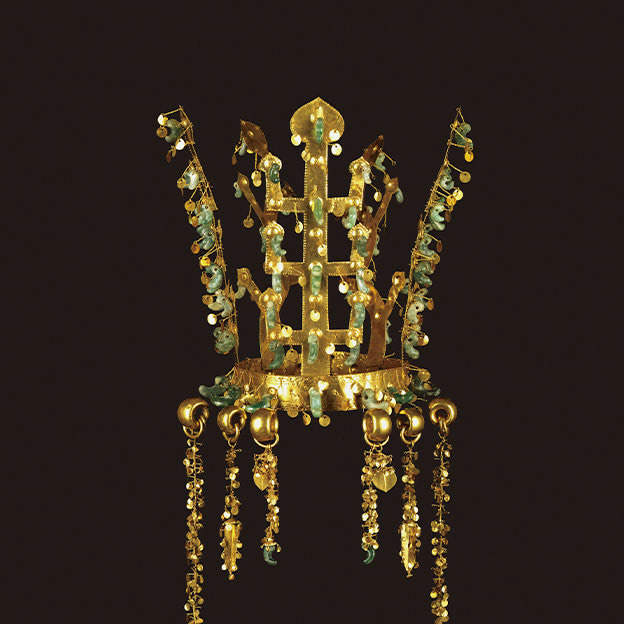
-
Gold Crown
Silla Kingdom (5th century)
National Treasure No.191
Height 27.5cm
The height of the golden crown is 27.5cm, the lengths of the decorations that hang down from it are 13-30.3cm. This golden crown is representative of the caps made during the Silla Dynasty. Three decorations in the shape of Chinese letters, meaning mountain (山), are attached to the front of the crown. Decorations in the form of deer horn are attached to both ends. The 16 pieces of crooked blue jades of the best quality were set for the three Chinese characters, 9 pieces of jade to form the deer horn, and 11 pieces on the head girdle. The crown is studded with a total of 77 pieces of jade. The balanced arrangement of gold decorations in the form of round shapes signifies a brilliant and lustrous golden crown. Suhasik decorations are hung from the cap in thick rings, three pieces on both sides. The longest of the suhasik decorations are on the outside and the shortest on the inside. The ends of the suhasik are decorated in blue jade, like that of the head girdle, and golden decks formed leaves on the outside. The head girdle and suhasik are assumed to belong to one another. The issue is only questionable because the suhasik was discovered separately from the crown. This crown is typical of the crowns worn during the Silla Dynasty, this one being especially more pretty and possessing more precious jades.
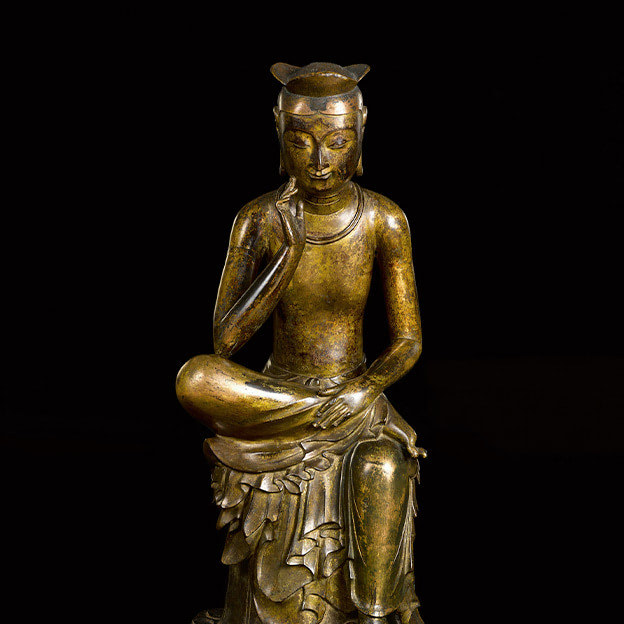
-
Pensive Bodhisattva
Silla, Early 7th century
Gilt bronze
National Treasure No. 83
Acquired in 1912, duk 3312
Height 93.5 cm, Weight 112.2kg
This statue strikes a classic contemplative pose: one leg perched up on the other knee, with fingers raised up against the cheek. This pose is quite common in Buddhist sculpture, and it was derived from the young Indian prince, Siddhartha Gautama, contemplating the nature of human life.
This Pensive Bodhisattva statue (designated as Korea’s National Treasure No. 83) is 93.5 cm tall, making it the tallest of all the pensive bodhisattvas made during the Three Kingdoms period (1st century BCE – 668 CE). Other distinguishing features of this statue include the crown, which is called either a Samsangwan (Crown with Three Peaks) or a Yeonhwagwan (Lotus Crown), and the simple yet elegant necklace that the prince wears on his naked upper torso. This sculpture is widely admired for the benign smile and fine physical proportions, which make it a splendid object of religious worship. This work closely resembles a red pine bodhisattva from Kōryūji temple in Japan, which was established by a Silla monk. Thus, this artistic masterpiece is also an important Buddhist statue, attesting to the exchange of Buddhist images between Korea and Japan during their early history.
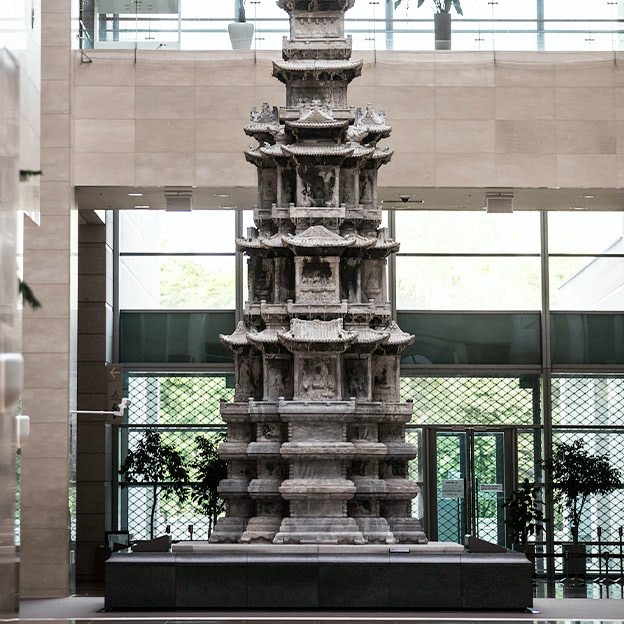
-
Ten-story Stone Pagoda from Gyeongcheonsa Temple Site
From Gyeongcheonsa Temple site in Gaepung, Gyeonggi-do Province
Goryeo Dynasty, 1348 (Fourth Year of the Reign of King Chungmok)
National Treasure No. 86
This pagoda harmoniously blending traditional Goryeo styles with Tibetan influences transmitted through Yuan China demonstrates exquisite beauty. On its base is a relief of the arduous journey taken by the Buddhist monk Xuanzang from the Tang Dynasty to bring Buddhist scriptures from India to China. The body of the pagoda from the first to fourth stories is engraved with scenes of sixteen Buddhist assemblies. This pagoda was illicitly transferred to Japan in 1907 but returned to Korea in 1918.
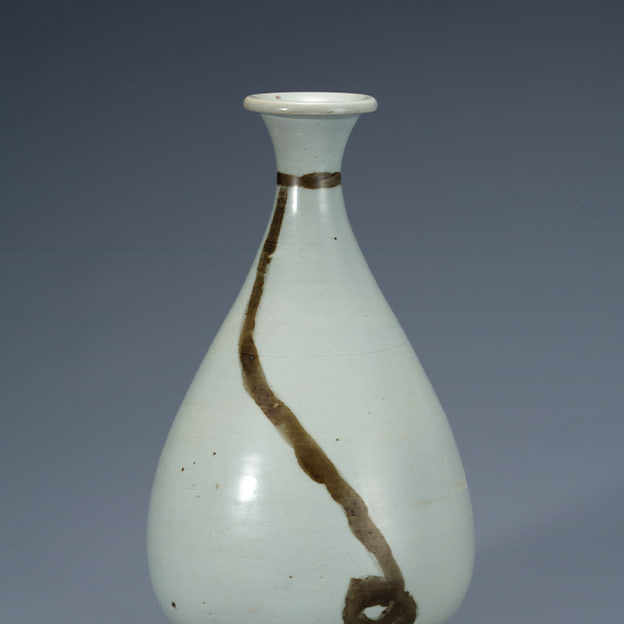
-
White Porcelain with Rope Design in Underglaze Iron-brown
Joseon, 16th century
H. 31.4cm
Treasure No. 1060
It represents the typical characteristics of solidity and curvaceousness of white porcelain of the early Joseon period. A strand of a rope that twines around the narrow neck and hangs down with its end rolled up is depicted in iron-brown glaze. Both simple design with lots of blank and strong lines drawn without hesitation boast about the prime stage of craftsmanship. Totally controlled description and composition of blank and design transcend craftsmanship toward a fine art. Rope design drawn diagonally without hesitation, is quite simple but give a strong impression. On the bottom of the base, some Korean characters were written in iron-brown glaze. Its meaning cannot be deciphered, but can be presumed that this bottle was produced after the invention of Hangeul.
